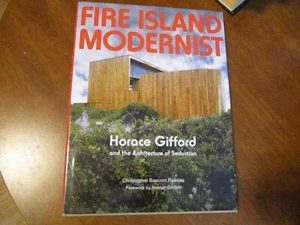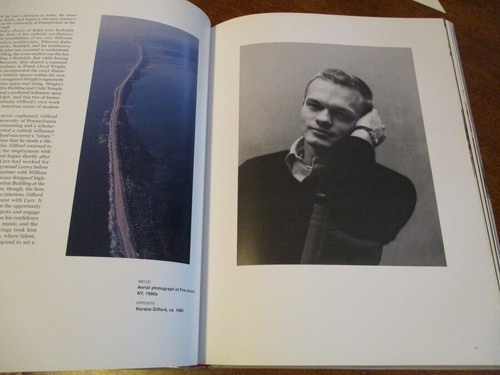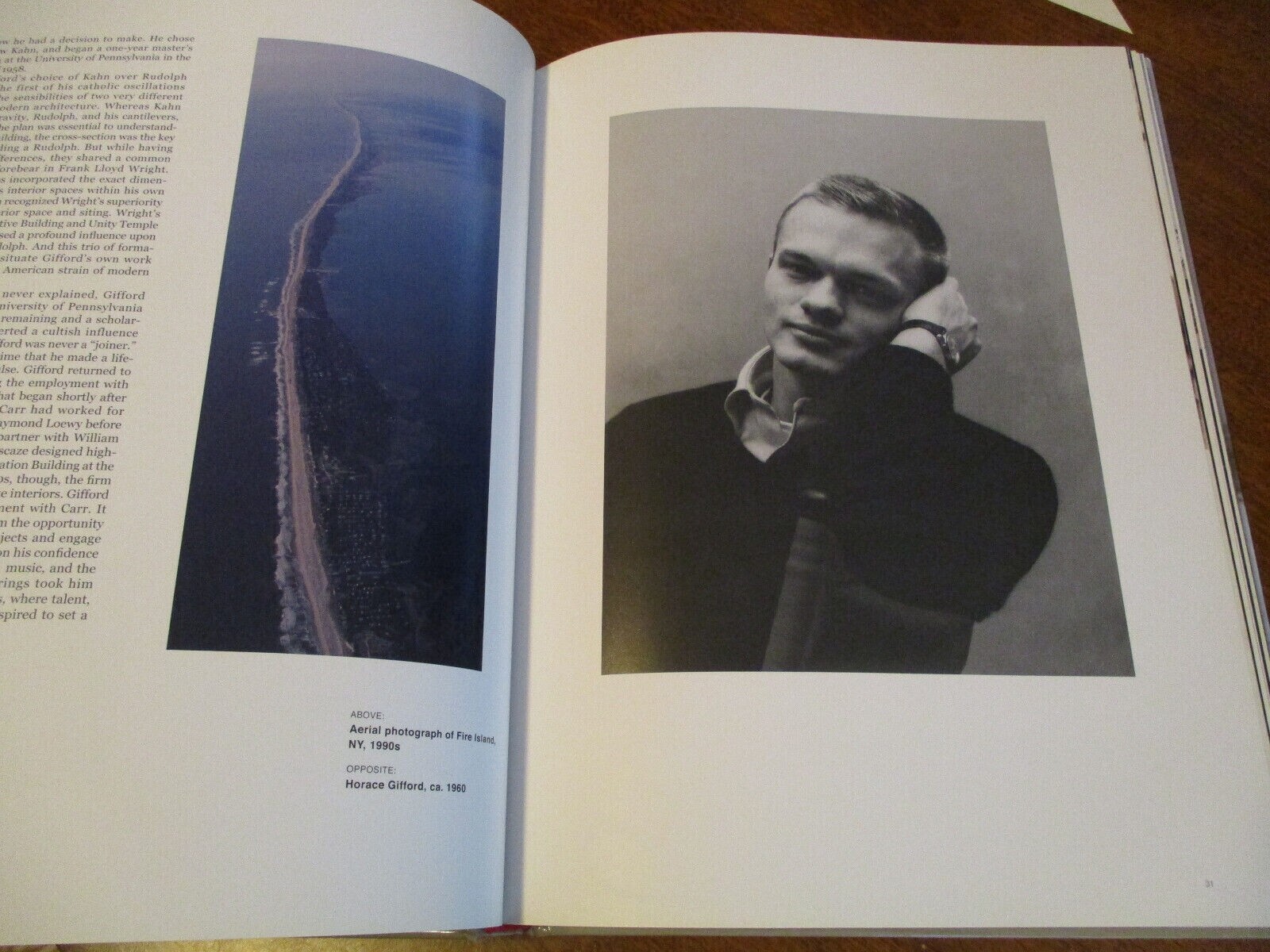Picture 1 of 12












Gallery
Picture 1 of 12












Have one to sell?
Fire Island Modernist Horace Gifford and the Architecture of Seduction
US $520.19
ApproximatelyRM 2,152.13
Was US $650.24 (20% off)
Condition:
Sale ends in: 3d 23h
Oops! Looks like we're having trouble connecting to our server.
Refresh your browser window to try again.
Shipping:
US $7.97 (approx RM 32.97) USPS Media MailTM.
Located in: Jupiter, Florida, United States
Delivery:
Estimated between Wed, 3 Dec and Tue, 9 Dec to 94104
Returns:
30 days return. Buyer pays for return shipping. If you use an eBay shipping label, it will be deducted from your refund amount.
Coverage:
Read item description or contact seller for details. See all detailsSee all details on coverage
(Not eligible for eBay purchase protection programmes)
About this item
Seller assumes all responsibility for this listing.
eBay item number:235503190271
Item specifics
- Condition
- ISBN
- 9781938922091
About this product
Product Identifiers
Publisher
D.A.P./Distributed Art Publishers
ISBN-10
1938922093
ISBN-13
9781938922091
eBay Product ID (ePID)
224473575
Product Key Features
Book Title
Fire Island Modernist: Horace Gifford and the Architecture of Seduction
Number of Pages
204 Pages
Language
English
Topic
Individual Architects & Firms / Monographs, General, Regional
Publication Year
2013
Illustrator
Yes
Genre
Architecture
Format
Hardcover
Dimensions
Item Height
1 in
Item Weight
53.6 Oz
Item Length
12.1 in
Item Width
9.4 in
Additional Product Features
Intended Audience
Trade
Reviews
Every once in a great while, there is a book that is immediately hailed as so essential one wonders not so much why it was never done before but how we managed to get by without it. If that sounds overly effusive, buy, borrow or steal Fire Island Modernist: Horace Gifford and the Architecture of Seduction and, after reading -- no, devouring it -- get back to me., In "Fire Island Modernist: Horace Gifford and the Architecture of Seduction," Christopher Rawlins presents an insightful and gorgeously illustrated account of the luminous midcentury modern vacation homes that architect Horace Gifford built during the 1960s and '70s in Fire Island's gay enclaves. But this beautiful book, published in May by Metropolis Books and Gordon de Vries Studio, contains more than blueprints: Rawlins fluidly merges a cultural history of New York's gay community with Gifford's personal biography and work, showing how his seductive designs were deeply connected to the newfound freedoms he and his clients enjoyed out on the beach., Horace Gifford, the designer of a series of modest but highly influential beach houses in Fire Island Pines, a small town on a spit of land some 50 miles east of New York City, was known for his irreverence... Gifford's houses... were emblematic of a time when even clients as rich as Calvin Klein were weekend minimalists, Fire Island wouldn't be the idyllic haven we know today if it weren't for Horace Gifford, a young, often overlooked architect from Florida who designed 78 stunning beach houses off its boardwalks between 1961 and 1980. In Fire Island Modernist: Horace Gifford and the Architecture of Seduction (Metropolis Books), a new monograph bursting with inspiring drawings and vintage photographs, author and architect Christopher Rawlins remembers this precocious (and handsome) talent who turned the south shores of Long Island into a modernist's dream., Rawlins book, full of gorgeous photographs drawings, illustrates Kahn's influence on Gifford. His understanding of servant and served spaces, and monumental form is beautifully documented.Salinger asked if we could grow-up, retain our optimism and not be considered naive. Given that Rawlin's book is as much social commentary as it is biogrpahy and architctural history, it asks questions regarding culture while explaining the cultural influences on the architect: can you understand and accept gay culture? Can you see the unique beauty of this culture? Can you see aspirations in the architecture? Can you do it while it evolves, on its own terms? Give this beautiful and thoughtful book, I remain optimistic., Throughout the late '60s and into the '70s, men like Mr. Gifford, Harry Bates, Earl Combs, Arthur Erickson, Andrew Geller and James McCloud -- not all of them gay -- were kept busy erecting elegant, stark structures on this austerely beautiful and fragile barrier island, houses of naturally weathering cedar, redwood pavilions set back from the boardwalk, their broad windows serving as prosceniums across which backlighted players in Speedos, or else nothing, played out a specific variant of the theater of late 20th century gay life., The first-ever account of the late Horace Gifford's architectural legacy on the infamous New York pleasure retreat reminds us that history is only ever what we make of it, as personal as it may be, or in this case, queer. Remembered by some for his impulsive ways, irresistible surfer looks, and porn-star appendage, Gifford's largely forgotten work reemerges as a serious voice in tune with post-war grandees like Louis Kahn and Paul Rudolph. Lovers of queer history will thank author Christopher Rawlins for detailing Gifford's beach homes on the barrier island alongside a social narrativie gilded by names like Calvin Klein, Oscar Wilde, and the Mattachine Society. As the sleepy enclave does sex, drugs, and disco, Rawlins covers all ground, from political punches to Gifford's liberated maxi-couches and make-out lofts. It's a sincere retelling which makes a courageous monument of an archive rescued from the rear of a suburban garage., In those days, the Pines was seen as an "untainted address," observes Christopher Rawlins in Fire Island Modernist, his new book about Horace Gifford, who designed just about one in ten houses there. Gifford was a strapping idealist, and his houses were communal, economical, and exhibitionistic: the bedrooms small, the central areas open, with everything wooden or glass (he "essentially treated all surfaces like floors," Rawlins writes)., Both a cultural history and an architectural mediation, Fire Island Modernist captures the look, feel and sensation of gay society in the 1960s and '70s that flourished on the sandy shores and shifting dunes of the 31-mile barrier island of its title... Rawlins's clear graceful prose has just the right tone and style for his subject, and his selection of photographs, drawings, and illustrations brings Gifford's times back to life... Photographs of handsome young men cavorting on the beach ad striking fashionable poses by the pool add to the book's glamourous ambience. As Alistair Gordon states in his foreword, Gifford's houses 'expressed the longings of a culture that had transformed Fire Island into a free-fire zone of social and sexual discovery., Though the thin spit of land off Long Island's coast has long been known as a summer getaway, Fire Island became a truly notable retreat when Horace Gifford brought his serene sensibility to its sandy shores in the '60s. Pictures of the Florida-born architect's modern cedar-and-glass bungalows support an engaging narrative worthy of the site's distinctively colorful heritage.
Number of Volumes
1 vol.
Dewey Decimal
720.92
Synopsis
As the 1960s became The Sixties, architect Horace Gifford executed a remarkable series of beach houses that transformed the terrain and culture of New York's Fire Island. Growing up on the beaches of Florida, Gifford forged a deep connection with coastal landscapes. Pairing this sensitivity with jazzy improvisations on modernist themes, he perfected a sustainable modernism in cedar and glass that was as attuned to natural landscapes as to our animal natures. Gifford's serene 1960s pavilions provided refuge from a hostile world, while his exuberant post-Stonewall, pre-AIDS masterpieces orchestrated bacchanals of liberation. Marilyn Monroe, Elizabeth Taylor and Montgomery Clift once spurned Hollywood limos for the rustic charm of Fire Island's boardwalks. Truman Capote wrote Breakfast at Tiffany's here. Diane von Furstenburg showed off her latest wrap dresses to an audience that included Halston, Giorgio Sant' Angelo, Calvin Klein and Geoffrey Beene. Today, such a roster evokes the aloof, gated compounds of the Hamptons or Malibu. But these celebrities lived in modestly scaled homes alongside middle-class vacationers, all with equal access to Fire Island's natural beauty. Blending cultural and architectural history, Fire Island Modernist ponders a fascinating era through an overlooked architect whose life, work and colorful milieu trace the operatic arc of a lost generation, and still resonate with artistic and historical import., Blending cultural and architectural history, Fire Island Modernist ponders a fascinating era of gay culture through an overlooked 1960s architect As the 1960s became The Sixties, architect Horace Gifford executed a remarkable series of beach houses that transformed the terrain and culture of New York's Fire Island. Growing up on the beaches of Florida, Gifford forged a deep connection with coastal landscapes. Pairing this sensitivity with jazzy improvisations on modernist themes, he perfected a sustainable modernism in cedar and glass that was as attuned to natural landscapes as to our animal natures. Gifford's serene 1960s pavilions provided refuge from a hostile world, while his exuberant post-Stonewall, pre-AIDS masterpieces orchestrated bacchanals of liberation. Marilyn Monroe, Elizabeth Taylor and Montgomery Clift once spurned Hollywood limos for the rustic charm of Fire Island's boardwalks. Truman Capote wrote Breakfast at Tiffany's here. Diane von Furstenburg showed off her latest wrap dresses to an audience that included Halston, Giorgio Sant' Angelo, Calvin Klein and Geoffrey Beene. Today, such a roster evokes the aloof, gated compounds of the Hamptons or Malibu. But these celebrities lived in modestly scaled homes alongside middle-class vacationers, all with equal access to Fire Island's natural beauty. Blending cultural and architectural history, Fire Island Modernist ponders a fascinating era through an overlooked architect whose life, work and colorful milieu trace the operatic arc of a lost generation, and still resonate with artistic and historical import.
LC Classification Number
NA737.G49R39 2013
Text by
Bascom Rawlins, Christopher
Item description from the seller
Popular categories from this store
Seller feedback (6,033)
- a***u (967)- Feedback left by buyer.Past yearVerified purchaseThe FOLIO Society Edition of Ray Bradbury's "Something Wicked This Way Comes" complete with slipcase arrived in perfect condition, just as described. I have never read this classic before, but I do love the movie that was made in the early 1980s and look forward to comparing them. The seller offered this collectible at a good price, beating other sellers. The book was packaged safely and arrived quickly. This is a trustworthy seller, so have no fear and bring your business here.😀 Thank you.SOMETHING WICKED THIS WAY COMES Ray Bradbury with slipcase FOLIO SOCIETY hardcv (#235635606165)
- y***u (268)- Feedback left by buyer.Past yearVerified purchaseListed as used in very good condition. Except for previous owner's name printed on fly page, appearance is indistinguishable from brand new and unread, so-better than expected. Book was carefully packed and very promptly shipped. It arrived undamaged. Prices for this high-quality book are all over the map, so this was a great value. Great seller. Would unhesitatingly do business with again.The Stanley Steamer America's Legendary Steam Car by Kit Foster 2004 (#235503190220)
- i***i (221)- Feedback left by buyer.Past yearVerified purchaseItem as described, packaged very well, and shipped really quickly. Seller responded to messages promptly. I’m thrilled to find this book in as good condition!Pioneer days on the shores of Lake Worth, 1873-1893 (#364823008199)
More to explore :
- Architecture Nonfiction Books,
- Architecture Architectural Digest Magazines,
- Architectural Digest Magazines,
- Architecture & Design Magazines,
- Architecture Architectural Digest Monthly Magazines,
- Architecture Architectural Digest Special Issue Magazines,
- Architecture Subscriptionless Magazines,
- Architecture Monthly Magazines,
- Architecture Details Magazines,
- Architecture Home Magazines